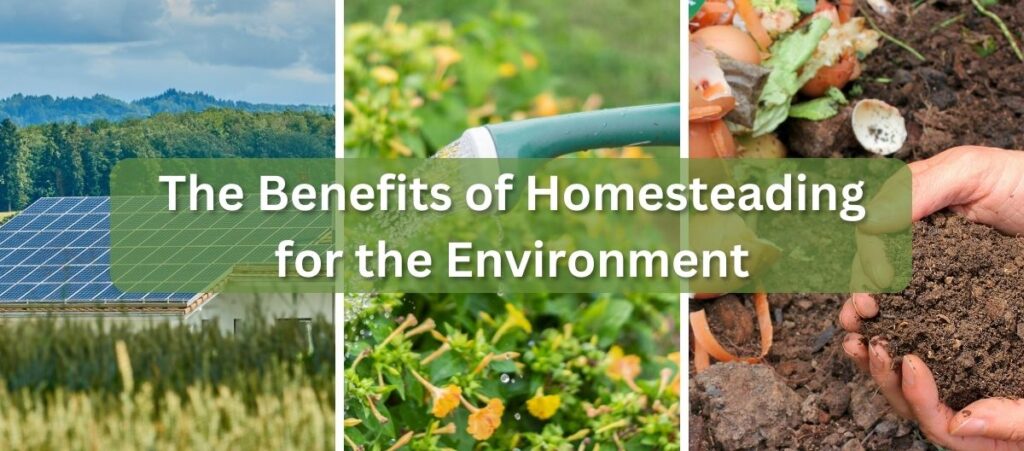
Homesteading is a lifestyle that involves living more self-sufficiently and sustainably. It can be done in a variety of ways, but it typically involves growing your own food, raising your own animals, and using renewable energy sources.
There are many benefits to homesteading for the environment. One of the biggest benefits is that it can help to reduce your carbon footprint. When you homestead, you are producing your own food and goods, which means that you are not relying on the transportation and manufacturing of goods that are produced in factories. This can help to reduce the amount of emissions that are released into the atmosphere.
Another benefit of homesteading is that it can help to conserve resources. When you grow your own food, you are not using as much water, fertilizer, and pesticides as you would if you were buying your food from a grocery store. You are also not contributing to the waste problem by generating less packaging and food waste.
Homesteading can also help to improve the environment. When you use permaculture techniques, you are working with nature to create a more sustainable ecosystem. This can help to improve soil quality, water quality, and biodiversity.
If you are looking for a way to live a more sustainable lifestyle, homesteading is a great option. It is a way to reduce your impact on the environment and improve your own quality of life.
Here are some specific examples of how homesteading can benefit the environment:
- Reduced carbon footprint: Homesteaders can reduce their carbon footprint by growing their own food, which reduces the need for transportation and storage of goods. This can lead to less energy consumption and fewer emissions.
- Transportation: When you grow your own food, you are not relying on the transportation of goods that are produced in factories. This can help to reduce the amount of emissions that are released into the atmosphere. For example, a study by the University of Michigan found that growing food locally can reduce greenhouse gas emissions by up to 50%.
- Storage: When you buy food from a grocery store, it has to be stored in warehouses and transported to the store. This requires energy, which can lead to emissions. By growing your own food, you can avoid this energy consumption and emissions.
- Food waste: When you grow your own food, you are more likely to use it all. This is because you are more connected to the food and you are more likely to cook it fresh. Food waste is a major contributor to greenhouse gas emissions, so reducing food waste can help to reduce your carbon footprint.
- Reduced waste: Homesteaders can reduce waste by composting food scraps and other organic materials. This can help to reduce the need for landfills and incinerators.
- Composting: Composting is a great way to reduce waste. When you compost food scraps and other organic materials, you turn them into nutrient-rich soil that can be used to grow plants. This can help to reduce the amount of waste that goes to landfills and incinerators.
- Recycling: Homesteaders can also reduce waste by recycling. This includes recycling paper, plastic, metal, and glass. Recycling helps to reduce the need for raw materials and energy, and it also helps to reduce pollution.
- Upcycling: Upcycling is another great way to reduce waste. This is when you take old materials and give them new life. For example, you could upcycle old clothes into new curtains or old furniture into a new coffee table. Upcycling helps to reduce waste and it also helps to save money.
- Conserved resources: Homesteaders can conserve resources by using rainwater harvesting, greywater recycling, and other water conservation techniques. They can also use renewable energy sources, such as solar and wind power, to reduce their reliance on fossil fuels.
- Water conservation: Water is a precious resource, and homesteaders can help to conserve it by using rainwater harvesting, greywater recycling, and other water conservation techniques. Rainwater harvesting is the collection of rainwater for use on plants and other non-potable purposes. Greywater recycling is the reuse of wastewater from sinks, showers, and laundry for non-potable purposes such as toilet flushing and irrigation. Other water conservation techniques include xeriscaping, which is the use of plants that are adapted to dry climates, and drip irrigation, which is a method of watering plants that delivers water directly to the roots.
- Renewable energy: Homesteaders can reduce their reliance on fossil fuels by using renewable energy sources, such as solar and wind power. Solar panels can be used to generate electricity, and wind turbines can be used to generate electricity or pump water. Other renewable energy sources include biomass, geothermal, and hydro.
- Improved soil quality: Homesteaders can improve soil quality by using cover crops, crop rotation, and other sustainable farming practices. This can help to reduce erosion and improve water infiltration.
- Cover crops: Cover crops are plants that are grown between cash crops. They help to improve soil quality by:
- Preventing erosion: Cover crops help to prevent erosion by holding the soil in place with their roots. This is especially important during periods of heavy rain or wind.
- Adding organic matter to the soil: Cover crops add organic matter to the soil when they die and decompose. This organic matter helps to improve the soil’s structure, water retention, and fertility.
- Improving water infiltration: Cover crops help to improve water infiltration by breaking up compacted soil and creating a network of pores that allow water to enter the soil more easily.
- Decreasing weed pressure: Cover crops help to decrease weed pressure by competing with weeds for sunlight, water, and nutrients.
- Providing habitat for beneficial insects and microorganisms: Cover crops provide habitat for beneficial insects and microorganisms, which help to improve soil health.
- Crop rotation: Crop rotation is the practice of planting different crops in the same field each year. This helps to improve soil quality by:
- Preventing the build-up of pests and diseases: Crop rotation helps to prevent the build-up of pests and diseases by breaking the life cycle of these pests and diseases.
- Adding different types of organic matter to the soil: Different crops add different types of organic matter to the soil. This helps to improve the soil’s diversity and fertility.
- Improving water infiltration: Crop rotation helps to improve water infiltration by breaking up compacted soil and creating a network of pores that allow water to enter the soil more easily.
- Decreasing soil compaction: Crop rotation helps to decrease soil compaction by allowing the soil to rest between crops.
- Other sustainable farming practices: Other sustainable farming practices that can help to improve soil quality include:
- No-till farming: No-till farming is the practice of planting crops without disturbing the soil. This helps to protect the soil from erosion and improve its water infiltration.
- Reduced tillage farming: Reduced tillage farming is the practice of using minimal tillage to prepare the soil for planting. This helps to protect the soil from erosion and improve its water infiltration.
- Mulching: Mulching is the practice of covering the soil with a layer of organic matter, such as leaves, straw, or bark. This helps to protect the soil from erosion, improve its water retention, and suppress weeds.
- Composting: Composting is the process of turning organic materials, such as food scraps, yard waste, and manure, into nutrient-rich soil amendment. This helps to improve the soil’s fertility and structure.
- Biodynamic farming: Biodynamic farming is a holistic approach to farming that emphasizes the use of natural methods and materials. Biodynamic farmers use cover crops, crop rotation, compost, and other sustainable farming practices to improve soil quality and produce healthy food.
- Cover crops: Cover crops are plants that are grown between cash crops. They help to improve soil quality by:
- Increased biodiversity: Homesteaders can increase biodiversity by planting native plants, providing food and shelter for wildlife, and managing their land in a sustainable way. This can help to protect endangered species and improve the overall health of the ecosystem.
- Planting native plants: Native plants are plants that are naturally found in a particular area. They are adapted to the local climate and soil conditions, and they provide food and shelter for wildlife. By planting native plants, homesteaders can help to increase biodiversity and improve the health of the ecosystem.
- Providing food and shelter for wildlife: Homesteaders can provide food and shelter for wildlife by planting native plants, providing water sources, and creating natural habitats. This can help to attract a variety of wildlife to the homestead, including birds, butterflies, bees, and other beneficial insects.
- Managing their land in a sustainable way: Homesteaders can manage their land in a sustainable way by using practices that protect the environment and conserve resources. This includes practices such as no-till farming, crop rotation, and composting. By managing their land in a sustainable way, homesteaders can help to protect biodiversity and improve the health of the ecosystem.
Homesteading is a great way to reduce your impact on the environment and improve your own quality of life. If you are interested in learning more about homesteading, there are many resources available online and in libraries. You can also find local homesteading groups and organizations that can provide support and advice.

